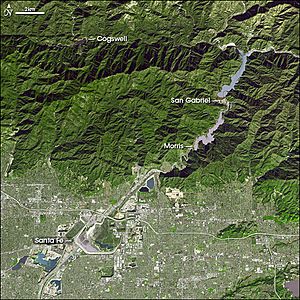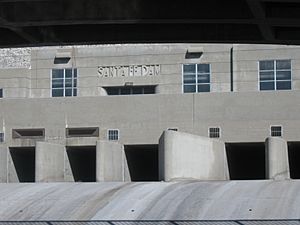Santa Fe Dam facts for kids
Quick facts for kids Santa Fe Dam |
|
|---|---|

Satellite view of four of the five major dams on the San Gabriel River system. Santa Fe Dam is the large structure on the bottom left (southwest).
|
|
| Country | United States |
| Location | Irwindale, California |
| Coordinates | 34°06′57″N 117°58′21″W / 34.11583°N 117.97250°W |
| Construction began | 1941 |
| Opening date | 1949 |
| Owner(s) | |
| Dam and spillways | |
| Type of dam | Earthfill |
| Impounds | San Gabriel River |
| Height | 92 ft (28 m) |
| Length | 23,800 ft (7,300 m) |
| Dam volume | 12,033,000 cu yd (9,200,000 m3) |
| Spillway type | Uncontrolled overflow |
| Spillway capacity | 200,000 cu ft/s (5,700 m3/s) |
| Reservoir | |
| Creates | Santa Fe Flood Control Basin |
| Total capacity | 45,409 acre⋅ft (56,011,000 m3) |
| Catchment area | 236 sq mi (610 km2) |
| Surface area | 1,000 acres (400 ha) |
| Power station | |
| Hydraulic head | 87 ft (27 m) |
The Santa Fe Dam is a special dam built to control floods on the San Gabriel River. It is located in Irwindale, which is in Los Angeles County, California, United States. This dam is about 92-foot (28 m) tall.
Most of the year, the area behind the dam, called its reservoir, is empty. But when big storms hit, it can hold over 45,000 acre-feet (56,000,000 m3) of water. (An acre-foot is enough water to cover one acre of land with water one foot deep!) When it's not rainy, the empty basin is used to help refill underground water supplies and for fun outdoor activities.
Contents
Building the Santa Fe Dam
Building the Santa Fe Dam started in 1941. The U.S. Army Corps of Engineers (USACE) led this huge project. They decided to build it after a very big flood hit the river in 1938.
Work on the dam stopped for a while in 1943 because of World War II. It started again in 1946. The main parts of the dam were finished by early 1947. The whole project, including the special gates that control water, was completed in January 1949. This was four months earlier than planned! The dam's main job was to protect towns along the San Gabriel River from floods.
Fun at Santa Fe Dam Recreation Area
In 1955, local leaders decided they wanted to create fun places for people at the dam. However, they didn't have enough money until 1974. A plan was made in 1975 to build recreation areas. The cost would be shared between the USACE and the county.
Most of the fun spots you see there today were built between 1976 and 1984. The county signed an agreement in 1976 to manage these areas for 50 years. This agreement was later extended until December 2036.
When the reservoir behind the Santa Fe Dam is empty, it becomes a great place for outdoor activities. The Santa Fe Dam Recreation Area is a huge 836-acre (338 ha) park located right behind the dam in Irwindale.
The best part of the park is its 70-acre (28 ha) lake. Here, you can rent boats, go fishing, or swim at the beach. There are also trails for hiking and cycling. You can also see many native California plants and areas that protect local wildlife.
How the Dam is Built
The Santa Fe Dam is shaped like a horseshoe. It's a strong structure built on the flat land next to the San Gabriel River. It stands about 3 mi (4.8 km) away from the San Gabriel Mountains.
The dam is made of different layers of earth. It is 92 feet (28 m) tall from its base and stands 87 feet (27 m) above the riverbed. It's one of the largest dams in the United States by the amount of material used to build it. The dam's wall is over four miles long and contains more than 12,000,000 cubic yards (9,200,000 m3) of material.
The reservoir behind the dam can hold up to 45,409 acre⋅ft (56,011,000 m3) of water when it's full. This is about 21 feet (6.4 m) below the very top of the dam. Water is let out of the dam using two sets of gates.
- The first set of gates is at the bottom of the dam. They have sixteen pipes, each about 7 ft (2.1 m) wide. These can release 17,000 cu ft/s (480 m3/s) of water.
- The emergency spillway is a concrete overflow area located to the northwest of the dam. It can handle a huge amount of water, up to 200,000 cu ft/s (5,700 m3/s).
How the Dam Works
The Santa Fe Dam works like a "dry dam." This means its reservoir is usually empty. When there's a big flood, the dam holds back the water. Then, the water is released slowly so it doesn't overflow the riverbanks downstream.
The dam's operations are carefully planned with other dams on the San Gabriel River. These include Whittier Narrows Dam (about 10 miles (16 km) downstream) and upstream dams like Cogswell, San Gabriel, and Morris. This teamwork helps protect cities along the river from floods. The Santa Fe Dam is the second largest dam on the San Gabriel River, after Whittier Narrows.
During the drier months (summer and autumn), most of the water flowing into the Santa Fe reservoir is sent to special areas called "Santa Fe Spreading Grounds." These areas help refill the underground water supply in the San Gabriel Valley. Any extra water can also go to other spreading grounds. Because of this, the San Gabriel River below the dam is often dry. The Los Angeles County Department of Public Works manages most of these spreading grounds. They help save about 110,000 acre⋅ft (140,000,000 m3) of water each year.




